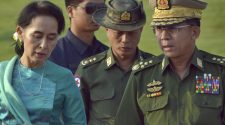Operation Protective Edge Credit: Israeli Defense Force IDF
TEL AVIV: The Israeli Defense Forces (IDF) plan a new multi-disciplinary department charged with listening to commanders operational needs and getting them the weapons they want as quickly as possible. The goal? To build a force ready to fight “fast and strong” (fast and furious would be more fun, no?) to hammer an enemy quickly enough to aboid paralyzing the Israeli population that lives within range of over 200.000 missiles deployed in Lebanon and Gaza.
Although few details are yet publicly available, the outline of the approach appears clear. A few months after Lt. Gen. Aviv Kochavi assumed command of the IDF he crafted a new multi-year plan for the Israeli military. Kochavi’s main target is the fast and maximum denial of enemy capabilities and the removal of the missile threat to the home front.
The acquisition goal appears similar to what has been happening in the much larger US military, where the four services increasingly sidestep the hulking bureaucracy that has conceived of and develop weapons since the end of the Cold War. They now often commission prototypes which are built quickly, tested and then turned into deployable weapons.
Today in Israel, the ideas often come from the large defense companies, IAI, Elbit systems and Rafael. They are submitted to the Defense Ministry’s ministry of defense directorate for Development of Arms and Technological Infrastructure (MAFAT) and then a long process follows until the development begins.

Israeli pilots check out V-22
This new effort is designed to overcome the problem that became clear in Operation Protective Edge. That led to 51 days of protracted combat. The critics say that the operation should have ended after a few days if the IDF had applied its fire power differently, and Kochavi appears to agree.
As a first step, Kochavi wants to increase the capabilities of the IDF’s “Spearhead” units – the special units that hit fast and strong. This part of the plan explains the urgent need for a replacement for the old CH-53 of the Israeli Air Force, and the urgent need for the Bell-Boeing V-22.
But at the same time, he wants to add multi-dimensional capabilities like cyber, drones, laser and even space. While all Israeli eyes are on Lebanon and Gaza, the existential threat is Iran building a nuclear bomb and developing longer-range ballistic missiles. This multi-dimensional approach is something that is going to be a major motive in the mufti-year plan.
This is all described in a paper that recently appeared in the IDF’s official journal, Maarachot. Both Iran and Russia are bringing advanced capabilities into the arena in the fields of fire, air defense, electronic warfare and cyber, say the two authors, reserve colonels Gabi Siboni, chief methodologist of the IDF’s conceptual laboratory, and Yuval Bazak, maneuverability team leader. “The Second Lebanon War and the Gaza operations proved the enemy’s ability to learn quickly, and transfer technology to operational capabilities. In future conflicts we may discover that capabilities that work well in routine, or even limited operations, may lose a great deal of their ability when operating in intensive conflicts,”
Siboni told Breaking Defense that the IDF must get ready for a war that will begin by surprise like the 1973 Yom Kippur war. “Such a scenario calls for increasing the capabilities of the local defense forces from among the inhabitants of the population in small villages and settlements in the south and northern parts of Israel,” he said.
But all this may run into the great defense bogey — budget problems. Aharon Ze’evi-Farkash, head of the Israeli Military Intelligence Directorate from 2002 to 2006, said be expects such a multi-year plan will meet budget hurdles. But major parts of it can still be performed if the IDF takes some efficiency steps.
On the operational side, Farkash stressed that excellent intelligence is crucial when huge military units are not likely to clash. “This is especially true when the wars today are not of big formations of armies that clash frontally, but of small units equipped with anti-tank weapons and long range rockets. To fight such a war and end it fast ,the IDF will need the best real-time intelligence data that will allow the shortest sensor to shooter to enable precise strikes of targets like rocket launchers hidden in highly populated areas,” Farkash said.
Lt . Gen. Cochavi comes from the intelligence corps of the IDF. There, a piece of information becomes a target almost in real time. “He wants something like this with the obvious limitations in everything that is related to give the fighting units the tools they need,” the former intelligence head said.


















